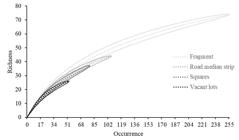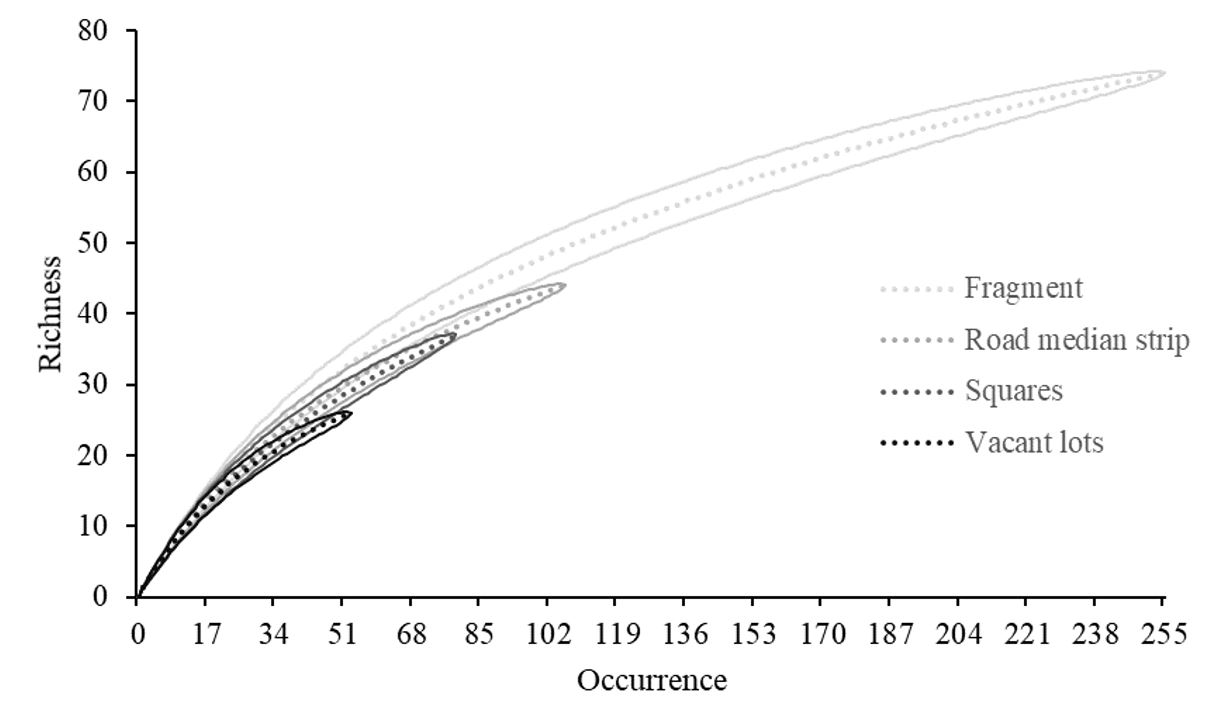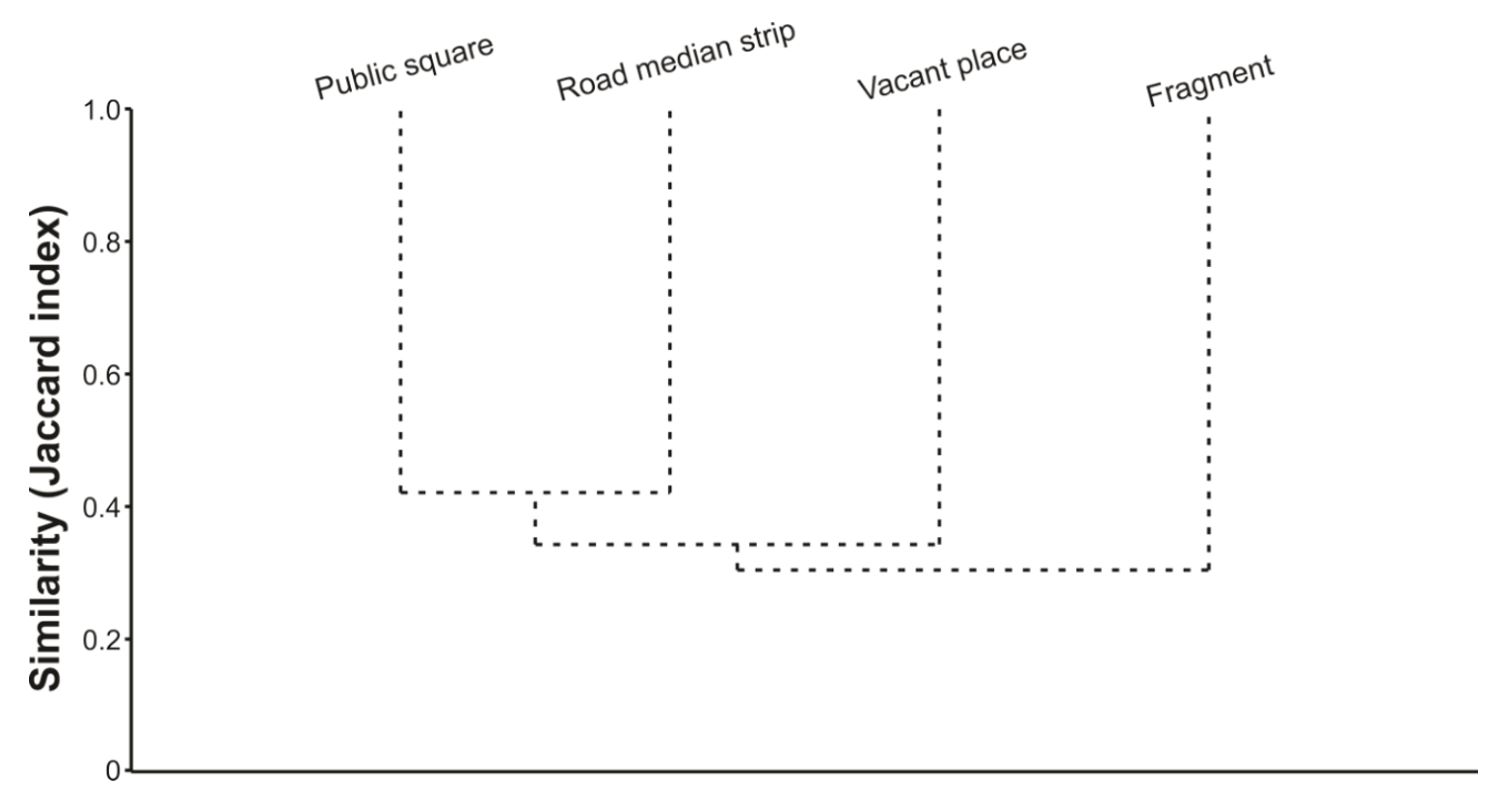One of the main causes for biodiversity loss is urbanization, mostly due to city growth in highly diverse areas and priority conservation areas, such as the Atlantic Forest (Brasil, 2002BRASIL. Ministério do Meio Ambiente – MMA, 2002. Biodiversidade brasileira: avaliação e identificação de áreas e ações prioritárias para conservação, utilização sustentável e repartição dos benefícios da biodiversidade nos biomas brasileiros. Brasília: Secretaria de Biodiversidade e Florestas, 404 p.; Melo and Delabie, 2017MELO, T.S. and DELABIE, J.H.C., 2017. Ecologia e conservação da biodiversidade de formigas em ambientes urbanos. In: O.C. BUENO, A.E.C. CAMPOS and M.S.C. MORINI, eds. Formigas em ambientes urbanos no Brasil. Bauru: Canal 6, pp. 189-240.; Conservation International, 2019CONSERVATION INTERNATIONAL, 2019 [viewed 12 December 2019]. Biodiversity hotspots [online]. Available from: https://www.conservation.org/priorities/biodiversity-hotspots
https://www.conservation.org/priorities/...
). Some of the major motivations for the conservation of urban biodiversity, include the preservation of local diversity, the protection of important populations and rare species, as well as the provision of ecosystem services (Dearborn and Kark, 2010DEARBORN, D.C. and KARK, S., 2010. Motivations for conserving urban biodiversity. Conservation Biology, vol. 24, no. 2, pp. 432-440. http://dx.doi.org/10.1111/j.1523-1739.2009.01328.x. PMid:19775276.
http://dx.doi.org/10.1111/j.1523-1739.20...
). To achieve this, it is essential to understand species diversity and distribution in urban areas.
In urban environments, green areas are important habitats for conservation as they house a large number of species (Nielsen et al., 2014NIELSEN, A.B., VAN DEN BOSCH, M., MARUTHAVEERAN, S. and VAN DEN BOSCH, C.K., 2014. Species richness in urban parks and its drivers: a review of empirical evidence. Urban Ecosystems, vol. 17, no. 1, pp. 305-327. http://dx.doi.org/10.1007/s11252-013-0316-1.
http://dx.doi.org/10.1007/s11252-013-031...
; Melo and Delabie, 2017MELO, T.S. and DELABIE, J.H.C., 2017. Ecologia e conservação da biodiversidade de formigas em ambientes urbanos. In: O.C. BUENO, A.E.C. CAMPOS and M.S.C. MORINI, eds. Formigas em ambientes urbanos no Brasil. Bauru: Canal 6, pp. 189-240.). With more than 16 thousand species/morph species of described ants (Bolton, 2019BOLTON, B. 2019 [viewed 11 November 2019]. AntWeb: versão 8.6.6 [software]. Available from: http://www.antweb.org
http://www.antweb.org...
), data on ants in urban environments has increased worldwide over the last 20 years, with the majority of studies being focused on species distribution (Santos, 2016SANTOS, M.N., 2016. Research on urban ants: approaches and gaps. Insectes Sociaux, vol. 63, no. 3, pp. 359-371. http://dx.doi.org/10.1007/s00040-016-0483-1.
http://dx.doi.org/10.1007/s00040-016-048...
). In Brazil, more than 490 ant species have been recorded in urban green areas (Melo and Delabie, 2017MELO, T.S. and DELABIE, J.H.C., 2017. Ecologia e conservação da biodiversidade de formigas em ambientes urbanos. In: O.C. BUENO, A.E.C. CAMPOS and M.S.C. MORINI, eds. Formigas em ambientes urbanos no Brasil. Bauru: Canal 6, pp. 189-240.), with a large number of species being registered in the city of Salvador, Bahia (Melo et al., 2014MELO, T.S., PERES, M.C.L., CHAVARI, J.L., BRESCOVIT, A.D. and DELABIE, J.H.C., 2014. Ants (Formicidae) and Spiders (Araneae) listed from the Metropolitan Region of Salvador, Brazil. Check List, vol. 10, no. 2, pp. 355-365. http://dx.doi.org/10.15560/10.2.355.
http://dx.doi.org/10.15560/10.2.355...
; Melo and Delabie, 2017MELO, T.S. and DELABIE, J.H.C., 2017. Ecologia e conservação da biodiversidade de formigas em ambientes urbanos. In: O.C. BUENO, A.E.C. CAMPOS and M.S.C. MORINI, eds. Formigas em ambientes urbanos no Brasil. Bauru: Canal 6, pp. 189-240.). Thus, with the aim of increasing the available knowledge on the ant species from Salvador, recorded by Melo et al. (2014)MELO, T.S., PERES, M.C.L., CHAVARI, J.L., BRESCOVIT, A.D. and DELABIE, J.H.C., 2014. Ants (Formicidae) and Spiders (Araneae) listed from the Metropolitan Region of Salvador, Brazil. Check List, vol. 10, no. 2, pp. 355-365. http://dx.doi.org/10.15560/10.2.355.
http://dx.doi.org/10.15560/10.2.355...
, we present an ant checklist with additional data for their occurrence in green areas.
Ants were collected in Salvador, Bahia, Brazil (12°58’S 38°30’W), between April and June 2019 at 62 sample points (SP). At each sample point we removed an area of leaf litter of size 50 × 50cm and installed a bait line as described below. Four green area categories were sampled: fragment (25 samples), road median strip (18), squares (13) and vacant lots (6), totaling 62 samples (Table 1). The SPs were at least 100 meters apart. At each SP we sampled the leaf litter and plants to ensure the detection of ant diversity. To sample the leaf litter fauna, we used a Winkler extractor in units of 50 × 50 cm, where we left the collected material exposed for 24h for fauna extraction. We collected the vegetation fauna in arboreal strata with the adapted bait line technique (Leponce et al., 2019LEPONCE, M., DELABIE, J.H.C., ORIVEL, J., JACQUEMIN, J., CALVO-MARTIN, M. and DEJEAN, A., 2019. Tree-dwelling ant survey (Hymenoptera, Formicidae) in Mitaraka, French Guiana. Zoosystema, vol. 41, no. 10, pp. 163-179. http://dx.doi.org/10.5252/zoosystema2019v41a10.
http://dx.doi.org/10.5252/zoosystema2019...
). This technique consists of putting a rope over the top of a tree, using a slingshot. We allocated baits every two meters along the rope from one meter above soil level to the highest tree point, and left them for three hours. We conducted surveys with authorization licenses nº 62268-1 from MMA/SISBIO and nº 2018-003254/TEC/PESQ-0006 from INEMA/DIRUC. The identification of morph species was acheived following Melo et al. (2014)MELO, T.S., PERES, M.C.L., CHAVARI, J.L., BRESCOVIT, A.D. and DELABIE, J.H.C., 2014. Ants (Formicidae) and Spiders (Araneae) listed from the Metropolitan Region of Salvador, Brazil. Check List, vol. 10, no. 2, pp. 355-365. http://dx.doi.org/10.15560/10.2.355.
http://dx.doi.org/10.15560/10.2.355...
and species nomenclature followed Bolton (2019)BOLTON, B. 2019 [viewed 11 November 2019]. AntWeb: versão 8.6.6 [software]. Available from: http://www.antweb.org
http://www.antweb.org...
. Ants were deposited in the collection of the Laboratório de Mirmecologia (CPDC, curator: J. Delabie), at the Comissão Executiva do Plano da Lavoura Cacaueira (CEPLAC, Itabuna, Bahia, Brazil), voucher #5846. We evaluated the variation in ant species richness according to the type of sampling method and the different types of green areas sampled. Additionally, we measured the similarity between green area types (fragment, road median strip, public square and vacant lots), and we used a Permutational Analysis of Variance (PERMANOVA), with Jaccard's similarity index as the association measure to evaluate differences in ant species composition. Rarefaction curves and Non-Metric Multidimensional Scaling (NMDS, Jaccard's distance) were produced in order to compare the richness between the environments. The statistical analyzes were performed using PAST 4.02 software (Hammer et al., 2001HAMMER, O., HARPER, D.A.T. and RYAN, P.D., 2001. PAST: paleontological statistics software package for education and data analysis. Palaeontologia Electronica, vol. 4, no. 1, pp. 9p.).
Description of green areas sampled and sampling effort in the city of Salvador, Bahia, Brazil.
We collected 93 ant species/morph species of 39 genera and six subfamilies (Table 2). Myrmicinae was the richest (S = 57 species), followed by Ponerinae (S = 12), Formicinae (S = 9), Dolichoderinae (S = 7), Pseudomyrmecinae (S = 4), Ectatomminae (S = 3), and Amblyoponinae (S = 1). In Brazil, Melo and Delabie (2017)MELO, T.S. and DELABIE, J.H.C., 2017. Ecologia e conservação da biodiversidade de formigas em ambientes urbanos. In: O.C. BUENO, A.E.C. CAMPOS and M.S.C. MORINI, eds. Formigas em ambientes urbanos no Brasil. Bauru: Canal 6, pp. 189-240. found a high number of species in urban environments from Atlantic Forest.
List of ant species collected in the city of Salvador, Bahia, Brazil, between April and June of 2019.
Five cities in the metropolitan region of Salvador (Bahia, S = 198 species) (Melo et al., 2014MELO, T.S., PERES, M.C.L., CHAVARI, J.L., BRESCOVIT, A.D. and DELABIE, J.H.C., 2014. Ants (Formicidae) and Spiders (Araneae) listed from the Metropolitan Region of Salvador, Brazil. Check List, vol. 10, no. 2, pp. 355-365. http://dx.doi.org/10.15560/10.2.355.
http://dx.doi.org/10.15560/10.2.355...
), ten cities in an inland city in Santa Catarina (S = 140) (Lutinski et al., 2013LUTINSKI, J.A., LOPES, B.C. and MORAIS, A.B.B., 2013. Diversidade de formigas urbanas (Hymenoptera: Formicidae) de dez cidades do sul do Brasil. Biota Neotropica, vol. 13, no. 3, pp. 332-342. http://dx.doi.org/10.1590/S1676-06032013000300033.
http://dx.doi.org/10.1590/S1676-06032013...
), three cities at Alto Tietê (São Paulo, S = 86) (Munhae et al., 2009MUNHAE, C.B., BUENO, Z.F.N., MORINI, M.S.C. and SILVA, R.R., 2009. Composition of the ant fauna (Hymenoptera: Formicidae) in public squares in Southern Brazil. Sociobiology, vol. 53, no. 2, pp. 455-472.), and the city of São Paulo (São Paulo, S = 79) (Morini et al., 2007MORINI, M.S.C., MUNHAE, C.B., LEUNG, R., CANDIANI, D.F. and VOLTOLINI, J.C., 2007. Comunidades de formigas (Hymenoptera, Formicidae) em fragmentos de Mata Atlântica situados em áreas urbanizadas. Iheringia, vol. 97, no. 3, pp. 246-252. http://dx.doi.org/10.1590/S0073-47212007000300005.
http://dx.doi.org/10.1590/S0073-47212007...
), presented the same number of species found in this study, even when implementing different sampling techniques and efforts. In these cities, representatives of Myrmicinae were found to have the highest richness followed by Formicinae and Ponerinae (Morini et al., 2007MORINI, M.S.C., MUNHAE, C.B., LEUNG, R., CANDIANI, D.F. and VOLTOLINI, J.C., 2007. Comunidades de formigas (Hymenoptera, Formicidae) em fragmentos de Mata Atlântica situados em áreas urbanizadas. Iheringia, vol. 97, no. 3, pp. 246-252. http://dx.doi.org/10.1590/S0073-47212007000300005.
http://dx.doi.org/10.1590/S0073-47212007...
; Munhae et al., 2009MUNHAE, C.B., BUENO, Z.F.N., MORINI, M.S.C. and SILVA, R.R., 2009. Composition of the ant fauna (Hymenoptera: Formicidae) in public squares in Southern Brazil. Sociobiology, vol. 53, no. 2, pp. 455-472.; Lutinski et al., 2013LUTINSKI, J.A., LOPES, B.C. and MORAIS, A.B.B., 2013. Diversidade de formigas urbanas (Hymenoptera: Formicidae) de dez cidades do sul do Brasil. Biota Neotropica, vol. 13, no. 3, pp. 332-342. http://dx.doi.org/10.1590/S1676-06032013000300033.
http://dx.doi.org/10.1590/S1676-06032013...
; Melo et al., 2014MELO, T.S., PERES, M.C.L., CHAVARI, J.L., BRESCOVIT, A.D. and DELABIE, J.H.C., 2014. Ants (Formicidae) and Spiders (Araneae) listed from the Metropolitan Region of Salvador, Brazil. Check List, vol. 10, no. 2, pp. 355-365. http://dx.doi.org/10.15560/10.2.355.
http://dx.doi.org/10.15560/10.2.355...
). Melo et al. (2014)MELO, T.S., PERES, M.C.L., CHAVARI, J.L., BRESCOVIT, A.D. and DELABIE, J.H.C., 2014. Ants (Formicidae) and Spiders (Araneae) listed from the Metropolitan Region of Salvador, Brazil. Check List, vol. 10, no. 2, pp. 355-365. http://dx.doi.org/10.15560/10.2.355.
http://dx.doi.org/10.15560/10.2.355...
recorded 164 species in the city of Salvador however, we reported 34 new species, increasing the number of ant species in Salvador urban green areas to 198.
A higher number of species was found in the leaf litter (Winkler extractor, S = 77; 46 exclusive species) than in the vegetation (bait line, S = 47; 16 exclusive species). Ant assemblage composition shows important differences according to strata (mostly in soil when compared to vegetation) (Wilson and Hölldobler, 2005WILSON, E.O. and HÖLLDOBLER, B., 2005. The rise of the ants: a phylogenetic and ecological explanation. Proceedings of the National Academy of Sciences of the United States of America, vol. 102, no. 21, pp. 7411-7414. http://dx.doi.org/10.1073/pnas.0502264102. PMid:15899976.
http://dx.doi.org/10.1073/pnas.050226410...
). Thus, a lower richness of arboreal species is expected as evolutionary history shows that ground ants specialize in resource selection, nesting places, and dispersal mechanisms and therefore, have an advantage when compared to vegetation assemblages (generalists) (Wilson and Hölldobler, 2005WILSON, E.O. and HÖLLDOBLER, B., 2005. The rise of the ants: a phylogenetic and ecological explanation. Proceedings of the National Academy of Sciences of the United States of America, vol. 102, no. 21, pp. 7411-7414. http://dx.doi.org/10.1073/pnas.0502264102. PMid:15899976.
http://dx.doi.org/10.1073/pnas.050226410...
). The sampling technique may be related to the lower arboreal richness observed, since baits can attract only a proportion of ant assemblies. Despite the recorded arboreal ant richness, nine new species were sampled: Azteca prox. alfari, A. severini Emery, 1896, Cephalotes atratus (Linnaeus, 1758), Dorymyrmex pyramicus (Roger, 1863), Myrmelachista sp.1, Pseudomyrmex sp.5 (group pallidus), P. curacaensis (Forel, 1912), Rogeria subarmata (Kempf, 1961) and Xenomyrmex sp.1.
Among the different types of green urban areas, forest fragments showed higher richness (S = 74 species; 32 exclusive species), followed by road median strips (S = 44; three exclusives), squares (S = 37; five exclusives), and vacant lots (S = 26; one exclusive) (Figure 1 and 2). We detected significant differences in ant species composition according to the type of green areas (F3,58 = 2.07; p < 0.001). Ant assemblages from road median strips and public squares were 42% more similar and 35% of those were similar to ants from vacant lots (Figure 3). Ants from forest fragments were 30% similar to all other green urban areas here studied. We recorded 10 species common to all green areas: Anochetus diegensis Forel, 1912, Brachymyrmex admotus Mayr, 1887, Cyphomyrmex transversus Emery, 1894, Hypoponera sp.3, Monomorium floricola (Jerdon, 1851), Paratrechina longicornis (Latreille, 1802), Pheidole megacephala (Fabricius, 1793), Solenopsis pollux Forel, 1893, Solenopsis sp.1 and Strumigenys carinithorax Borgmeier, 1934 (Table 2). A high richness of native ants has been reported in cities with different levels of anthropogenic disturbance (Santos, 2016SANTOS, M.N., 2016. Research on urban ants: approaches and gaps. Insectes Sociaux, vol. 63, no. 3, pp. 359-371. http://dx.doi.org/10.1007/s00040-016-0483-1.
http://dx.doi.org/10.1007/s00040-016-048...
; Melo and Delabie, 2017MELO, T.S. and DELABIE, J.H.C., 2017. Ecologia e conservação da biodiversidade de formigas em ambientes urbanos. In: O.C. BUENO, A.E.C. CAMPOS and M.S.C. MORINI, eds. Formigas em ambientes urbanos no Brasil. Bauru: Canal 6, pp. 189-240.). Conserved environments, such as native fragments, have higher ant species richness compared to impacted ones such as road median strips, public squares, and vacant lots (Melo and Delabie, 2017MELO, T.S. and DELABIE, J.H.C., 2017. Ecologia e conservação da biodiversidade de formigas em ambientes urbanos. In: O.C. BUENO, A.E.C. CAMPOS and M.S.C. MORINI, eds. Formigas em ambientes urbanos no Brasil. Bauru: Canal 6, pp. 189-240.). Therefore, we highlight the importance of maintaining more conserved green areas in order to preserve ant species. Although additional research and methods would allow for the detection of more ant species, this study has deepened the knowledge available on ants from Salvador.
Rarefaction curve (dotted line) comparing the ant richness of different green areas studied in Salvador, Bahia, Brazil. Continuous line: confidence interval.
Acknowledgements
Thanks are given to the Ministério do Meio Ambiente – MMA and Instituto do Meio Ambiente e Recursos Hídricos – INEMA for the collection permits, to Icaro Silva e Mendonça and Lais Leal Lopes for reviewing the English text and anonymous reviewers for contributions. TSM thanks CAPES for the scholarship provided and JHCD acknowledges his research grant from CNPq (process 304629/2018-9).
References
- BOLTON, B. 2019 [viewed 11 November 2019]. AntWeb: versão 8.6.6 [software]. Available from: http://www.antweb.org
» http://www.antweb.org - BRASIL. Ministério do Meio Ambiente – MMA, 2002. Biodiversidade brasileira: avaliação e identificação de áreas e ações prioritárias para conservação, utilização sustentável e repartição dos benefícios da biodiversidade nos biomas brasileiros Brasília: Secretaria de Biodiversidade e Florestas, 404 p.
- CONSERVATION INTERNATIONAL, 2019 [viewed 12 December 2019]. Biodiversity hotspots [online]. Available from: https://www.conservation.org/priorities/biodiversity-hotspots
» https://www.conservation.org/priorities/biodiversity-hotspots - DEARBORN, D.C. and KARK, S., 2010. Motivations for conserving urban biodiversity. Conservation Biology, vol. 24, no. 2, pp. 432-440. http://dx.doi.org/10.1111/j.1523-1739.2009.01328.x PMid:19775276.
» http://dx.doi.org/10.1111/j.1523-1739.2009.01328.x - HAMMER, O., HARPER, D.A.T. and RYAN, P.D., 2001. PAST: paleontological statistics software package for education and data analysis. Palaeontologia Electronica, vol. 4, no. 1, pp. 9p.
- LEPONCE, M., DELABIE, J.H.C., ORIVEL, J., JACQUEMIN, J., CALVO-MARTIN, M. and DEJEAN, A., 2019. Tree-dwelling ant survey (Hymenoptera, Formicidae) in Mitaraka, French Guiana. Zoosystema, vol. 41, no. 10, pp. 163-179. http://dx.doi.org/10.5252/zoosystema2019v41a10
» http://dx.doi.org/10.5252/zoosystema2019v41a10 - LUTINSKI, J.A., LOPES, B.C. and MORAIS, A.B.B., 2013. Diversidade de formigas urbanas (Hymenoptera: Formicidae) de dez cidades do sul do Brasil. Biota Neotropica, vol. 13, no. 3, pp. 332-342. http://dx.doi.org/10.1590/S1676-06032013000300033
» http://dx.doi.org/10.1590/S1676-06032013000300033 - MELO, T.S. and DELABIE, J.H.C., 2017. Ecologia e conservação da biodiversidade de formigas em ambientes urbanos. In: O.C. BUENO, A.E.C. CAMPOS and M.S.C. MORINI, eds. Formigas em ambientes urbanos no Brasil Bauru: Canal 6, pp. 189-240.
- MELO, T.S., PERES, M.C.L., CHAVARI, J.L., BRESCOVIT, A.D. and DELABIE, J.H.C., 2014. Ants (Formicidae) and Spiders (Araneae) listed from the Metropolitan Region of Salvador, Brazil. Check List, vol. 10, no. 2, pp. 355-365. http://dx.doi.org/10.15560/10.2.355
» http://dx.doi.org/10.15560/10.2.355 - MORINI, M.S.C., MUNHAE, C.B., LEUNG, R., CANDIANI, D.F. and VOLTOLINI, J.C., 2007. Comunidades de formigas (Hymenoptera, Formicidae) em fragmentos de Mata Atlântica situados em áreas urbanizadas. Iheringia, vol. 97, no. 3, pp. 246-252. http://dx.doi.org/10.1590/S0073-47212007000300005
» http://dx.doi.org/10.1590/S0073-47212007000300005 - MUNHAE, C.B., BUENO, Z.F.N., MORINI, M.S.C. and SILVA, R.R., 2009. Composition of the ant fauna (Hymenoptera: Formicidae) in public squares in Southern Brazil. Sociobiology, vol. 53, no. 2, pp. 455-472.
- NIELSEN, A.B., VAN DEN BOSCH, M., MARUTHAVEERAN, S. and VAN DEN BOSCH, C.K., 2014. Species richness in urban parks and its drivers: a review of empirical evidence. Urban Ecosystems, vol. 17, no. 1, pp. 305-327. http://dx.doi.org/10.1007/s11252-013-0316-1
» http://dx.doi.org/10.1007/s11252-013-0316-1 - SANTOS, M.N., 2016. Research on urban ants: approaches and gaps. Insectes Sociaux, vol. 63, no. 3, pp. 359-371. http://dx.doi.org/10.1007/s00040-016-0483-1
» http://dx.doi.org/10.1007/s00040-016-0483-1 - WILSON, E.O. and HÖLLDOBLER, B., 2005. The rise of the ants: a phylogenetic and ecological explanation. Proceedings of the National Academy of Sciences of the United States of America, vol. 102, no. 21, pp. 7411-7414. http://dx.doi.org/10.1073/pnas.0502264102 PMid:15899976.
» http://dx.doi.org/10.1073/pnas.0502264102
Publication Dates
-
Publication in this collection
02 Apr 2021 -
Date of issue
2022
History
-
Received
07 Apr 2020 -
Accepted
23 July 2020







